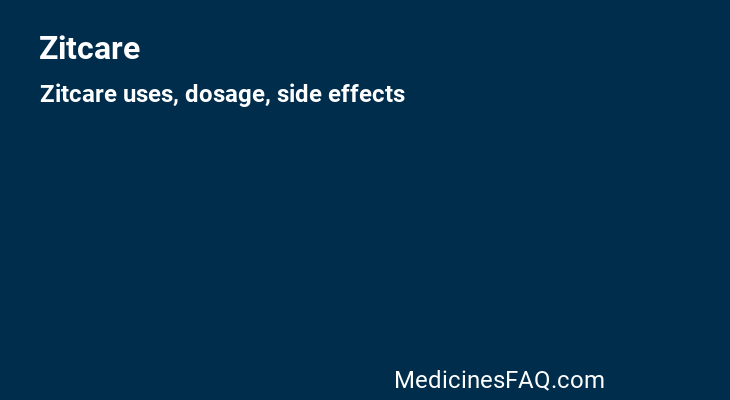Zitcare
Zitcare Uses, Dosage, Side Effects, Food Interaction and all others data.
Beta-carotene, with the molecular formula C40H56, belongs to the group of carotenoids consisting of isoprene units. The presence of long chains of conjugated double bonds donates beta-carotene with specific colors. It is the most abundant form of carotenoid and it is a precursor of the vitamin A. Beta-carotene is composed of two retinyl groups. It is an antioxidant that can be found in yellow, orange and green leafy vegetables and fruits. Under the FDA, beta-carotene is considered as a generally recognized as safe substance (GRAS).
Oral administration of beta-carotene increases the serum concentration of beta-carotene by 60% but it does not change the concentration found in the heart, liver or kidneys. In vitro studies in hepatocytes have shown that beta-carotene ameliorates oxidative stress, enhances antioxidant activity and decreases apoptosis.
Other than the antioxidant activities, some other actions have been correlated to beta-carotene. It is thought to have detoxifying properties, as well as to help increase resistance to inflammation and infection and increase immune response and enhance RNA production.
Chromium picolinate has a chemical formula CrPic3 and reddish-pink color. It is a coordination complex consisting of chromium(III) and picolinic acid. Chromium picolinate is used as a nutritional supplement for optimal insulin function in patients with Type 2 diabetes or promotion of weight loss. Chromium ions are shown to regulate insulin by promoting glucose utilization and increasing the sensitivity of the insulin receptor .
Magnesium is the second most plentiful cation of the intracellular fluids. It is essential for the activity of many enzyme systems and plays an important role with regard to neurochemical transmission and muscular excitability. Deficits are accompanied by a variety of structural and functional disturbances.
Magnesium sulfate is a small colorless crystal used as an anticonvulsant, a cathartic, and an electrolyte replenisher in the treatment of pre-eclampsia and eclampsia. It causes direct inhibition of action potentials in myometrial muscle cells. Excitation and contraction are uncoupled, which decreases the frequency and force of contractions. Magnesium sulfate is gaining popularity as an initial treatment in the management of various dysrhythmias, particularly torsades de pointes, and dyrhythmias secondary to TCA overdose or digitalis toxicity.
A metallic element of atomic number 30 and atomic weight 65.38. It is a necessary trace element in the diet, forming an essential part of many enzymes, and playing an important role in protein synthesis and in cell division. Zinc deficiency is associated with anemia, short stature, hypogonadism, impaired wound healing, and geophagia. It is identified by the symbol Zn .
A newer study suggests implies that an imbalance of zinc is associated with the neuronal damage associated with traumatic brain injury, stroke, and seizures .
Understanding the mechanisms that control brain zinc homeostasis is, therefore, imperative to the development of preventive and treatment regimens for these and other neurological disorders .
| Trade Name | Zitcare |
| Generic | L-selenium + Chromium Picolinate + Beta Carotene + Zinc + Copper Sulfate + Magnesium Sulfate |
| Weight | 200mcg |
| Type | Capsule |
| Therapeutic Class | |
| Manufacturer | Canixa Life Sciences |
| Available Country | India |
| Last Updated: | September 19, 2023 at 7:00 am |

Uses
Beta carotene is a vitamin A precursor found in various nutritional supplements and health products.
Beta-carotene is FDA approved to be used as a nutrient supplement and to be even added in infant formula as a source of vitamin A. It is also approved to be used as a color additive for food products, drugs (with the label of "only as a color additive") and cosmetics.
It is used commonly for the reduction of photosensitivity in patients with erythropoietic protoporphyria and other photosensitivity diseases.
Magnesium sulfate injection is used for the following conditions:
Convulsions (treatment) - Intravenous Magnesium sulfate injection is used for immediate control of life-threatening convulsions in the treatment of severe toxemias (pre-eclampsia and eclampsia) of pregnancy and in the treatment of acute nephritis in children.
Hypomagnesemia (prophylaxis and treatment) - Magnesium sulfate injection is used for replacement therapy in magnesium deficiency, especially in acute hypomagnesemia accompanied by signs of tetany similar to those of hypocalcemia.
Magnesium sulfate injection is also used to prevent or treat magnesium deficiency in patients receiving total parenteral nutrition.
Tetany, uterine (treatment) - Magnesium sulfate injection is used for uterine tetany as a myometrial relaxant.
Zinc is an essential element commonly used for the treatment of patients with documented zinc deficiency.
Zinc can be used for the treatment and prevention of zinc deficiency/its consequences, including stunted growth and acute diarrhea in children, and slowed wound healing. It is also utilized for boosting the immune system, treating the common cold and recurrent ear infections, as well as preventing lower respiratory tract infections .
Zitcare is also used to associated treatment for these conditions: Deficiency, Vitamin A, Nutritional supplementationNutritional supplementationConstipation, Convulsions, Hypomagnesemia, Torsades de Pointes, Barium poisoning, Severe Exacerbation of asthma, Bowel preparation therapy, Soaking aid for minor sprains and bruisesCandidiasis, Common Cold, Diaper Dermatitis, Diaper Rash, Eye redness, Iron Deficiency (ID), Ocular Irritation, Skin Irritation, Sunburn, Wilson's Disease, Zinc Deficiency, Dietary and Nutritional Therapies, Dietary supplementation
How Zitcare works
Beta-carotene is an antioxidant that presents significant efficacy against the reactive oxygen species singlet oxygen. Beta-carotene acts as a scavenger of lipophilic radicals within the membranes of every cell compartments. It also presents an oxidative modification of LDL. The presence of long chains of conjugated double bonds is responsible for its antioxidative properties by allowing beta-carotene to chelate oxygen-free radicals and dissipate their energy. The chelation of free radicals inhibits the peroxidation of lipids.
The effect of beta-carotene in the immune response is thought to be related to the direct effect on the thymus which increases the production of immune cells.
Magnesium is the second most plentiful cation of the intracellular fluids. It is essential for the activity of many enzyme systems and plays an important role with regard to neurochemical transmission and muscular excitability. Magnesium sulfate reduces striated muscle contractions and blocks peripheral neuromuscular transmission by reducing acetylcholine release at the myoneural junction. Additionally, Magnesium inhibits Ca2+ influx through dihydropyridine-sensitive, voltage-dependent channels. This accounts for much of its relaxant action on vascular smooth muscle.
Zinc has three primary biological roles: catalytic, structural, and regulatory. The catalytic and structural role of zinc is well established, and there are various noteworthy reviews on these functions. For example, zinc is a structural constituent in numerous proteins, inclusive of growth factors, cytokines, receptors, enzymes, and transcription factors for different cellular signaling pathways. It is implicated in numerous cellular processes as a cofactor for approximately 3000 human proteins including enzymes, nuclear factors, and hormones .
Zinc promotes resistance to epithelial apoptosis through cell protection (cytoprotection) against reactive oxygen species and bacterial toxins, likely through the antioxidant activity of the cysteine-rich metallothioneins .
In HL-60 cells (promyelocytic leukemia cell line), zinc enhances the up-regulation of A20 mRNA, which, via TRAF pathway, decreases NF-kappaB activation, leading to decreased gene expression and generation of tumor necrosis factor-alpha (TNF-alpha), IL-1beta, and IL-8 .
There are several mechanisms of action of zinc on acute diarrhea. Various mechanisms are specific to the gastrointestinal system: zinc restores mucosal barrier integrity and enterocyte brush-border enzyme activity, it promotes the production of antibodies and circulating lymphocytes against intestinal pathogens, and has a direct effect on ion channels, acting as a potassium channel blocker of adenosine 3-5-cyclic monophosphate-mediated chlorine secretion. Cochrane researchers examined the evidence available up to 30 September 2016 .
Zinc deficiency in humans decreases the activity of serum thymulin (a hormone of the thymus), which is necessary for the maturation of T-helper cells. T-helper 1 (Th(1)) cytokines are decreased but T-helper 2 (Th(2)) cytokines are not affected by zinc deficiency in humans [A342417].
The change of Th(1) to Th(2) function leads to cell-mediated immune dysfunction. Because IL-2 production (Th(1) cytokine) is decreased, this causes decreased activity of natural-killer-cell (NK cell) and T cytolytic cells, normally involved in killing viruses, bacteria, and malignant cells [A3424].
In humans, zinc deficiency may lead to the generation of new CD4+ T cells, produced in the thymus. In cell culture studies (HUT-78, a Th(0) human malignant lymphoblastoid cell line), as a result of zinc deficiency, nuclear factor-kappaB (NF-kappaB) activation, phosphorylation of IkappaB, and binding of NF-kappaB to DNA are decreased and this results in decreased Th(1) cytokine production .
In another study, zinc supplementation in human subjects suppressed the gene expression and production of pro-inflammatory cytokines and decreased oxidative stress markers [A3424]. In HL-60 cells (a human pro-myelocytic leukemia cell line), zinc deficiency increased the levels of TNF-alpha, IL-1beta, and IL-8 cytokines and mRNA. In such cells, zinc was found to induce A20, a zinc finger protein that inhibited NF-kappaB activation by the tumor necrosis factor receptor-associated factor pathway. This process decreased gene expression of pro-inflammatory cytokines and oxidative stress markers .
The exact mechanism of zinc in acne treatment is poorly understood. However, zinc is considered to act directly on microbial inflammatory equilibrium and facilitate antibiotic absorption when used in combination with other agents. Topical zinc alone as well as in combination with other agents may be efficacious because of its anti-inflammatory activity and ability to reduce P. acnes bacteria by the inhibition of P. acnes lipases and free fatty acid levels .
Dosage
Zitcare dosage
Intramuscular:Adults and older children: For severe hypomagnesemia, 1 to 5 g (2 to 10 mLof 50% solution) daily in divided doses; administration is repeated daily until serum levels have returned to normal. If deficiency is not severe, 1 g (2 mL of 50% solution) can be given once or twice daily. Serum magnesium levels should serve as a guide to continued dosage.
Intravenous:1 to 4 g magnesium sulfate (magnesium sulfate (magnesium sulfate injection) injection) may be given intravenously in 10% to 20% solution, but only with great caution; the rate should not exceed 1.5 mL of 10% solution or equivalent per minute until relaxation is obtained.
Intravenous Infusion:4 g in 250 mL of 5% Dextrose Injection at a rate not exceeding 3 mL per minute.
Usual Dose Range:1 to 40 g daily.
Electrolyte Replenisher:Intramuscular 1 to 2 g in 50% solution four times a day until serum magnesium is within normal limits.
Usual Pediatric Dose:Intramuscular 20 to 40 mg per kg of body weight in a 20% solution repeated as necessary.
For Eclampsia:Initially 1 to 2 g in 25% or 50% solution is given intramuscularly. Subsequently, 1 g is given every 30 minutes until relief is obtained. The blood pressure should be monitored after each injection.
Parenteral drug products should be inspected visually for particulate matter and discoloration prior to administration, whenever solution and container permit.
Side Effects
Flushing, sweating, sharply lowered blood pressure, hypothermia, stupor and ultimately, respiratory depression.
Toxicity
Beta-carotene is not toxic but the high and constant administration of this substance can translate into skin yellow coloration. Some reports have indicated that administration of high and periodic doses of beta-carotene are correlated to the increase in cancer incidence. This risk seems to be very elevated in the case of smokers. The registered LD50 of beta-carotene is >5000 mg/kg.
LD50 = 1200 mg/kg (rat, subcutaneous). May be harmful if swallowed. May act as an irritant. Adverse reactions include hypotension, ECG changes, diarrhea, urinary retention, CNS depression and respiratory depression.
According to the Toxnet database of the U.S. National Library of Medicine, the oral LD50 for zinc is close to 3 g/kg body weight, more than 10-fold higher than cadmium and 50-fold higher than mercury .
The LD50 values of several zinc compounds (ranging from 186 to 623 mg zinc/kg/day) have been measured in rats and mice .
Precaution
Renal impairment, myasthaenia gravis, digitalised patients; pregnancy. Monitor serum-magnesium concentrations.
Volume of Distribution
No pharmacokinetic studies have been performed regarding the volume of distribution of beta-carotene.
A pharmacokinetic study was done in rats to determine the distribution and other metabolic indexes of zinc in two particle sizes. It was found that zinc particles were mainly distributed to organs including the liver, lung, and kidney within 72 hours without any significant difference being found according to particle size or rat gender .
Elimination Route
After administration of beta-carotene, some of the administered dose is absorbed into the circulatory system unchanged and stored in the fat tissue. The coadministration of beta-carotene and a high-fat content diet is correlated to a better absorption of beta-carotene. The absorption is also dependent on the isomeric form of the molecule where the cis conformation seems to present a higher bioavailability. The absorption of beta-carotene is thought to be performed in 6-7 hours.
The reported AUC of beta-carotene when administered orally from 0 to 440 hours after initial administration was reported to be 26.3 mcg.h/L. The maximal concentration of beta-carotene is attained in a dual pharmacokinetic profile after 6 hours and again after 32 hours with a concentration of 0.58 micromol/L.
Zinc is absorbed in the small intestine by a carrier-mediated mechanism . Under regular physiologic conditions, transport processes of uptake do not saturate. The exact amount of zinc absorbed is difficult to determine because zinc is secreted into the gut. Zinc administered in aqueous solutions to fasting subjects is absorbed quite efficiently (at a rate of 60-70%), however, absorption from solid diets is less efficient and varies greatly, dependent on zinc content and diet composition .
Generally, 33% is considered to be the average zinc absorption in humans . More recent studies have determined different absorption rates for various populations based on their type of diet and phytate to zinc molar ratio. Zinc absorption is concentration dependent and increases linearly with dietary zinc up to a maximum rate [L20902].
Additionally zinc status may influence zinc absorption. Zinc-deprived humans absorb this element with increased efficiency, whereas humans on a high-zinc diet show a reduced efficiency of absorption .
Half Life
The apparent half-life of beta-carotene is of 6-11 days after initial administration.
43.2 hours (for newborns)
The half-life of zinc in humans is approximately 280 days .
Clearance
The clearance rate of beta-carotene administered orally is 0.68 nmol/L each hour.
In one study of healthy patients, the clearance of zinc was found to be 0.63 ± 0.39 μg/min .
Elimination Route
The unabsorbed carotene is excreted in feces. It is also excreted in feces and urine as metabolites. The consumption of dietary fiber can increase the fecal excretion of fats and other fat-soluble compounds such as beta-carotene.
Magnesium is excreted solely by the kidney at a rate proportional to the serum concentration and glomerular filtration.
The excretion of zinc through gastrointestinal tract accounts for approximately one-half of all zinc eliminated from the body .
Considerable amounts of zinc are secreted through both biliary and intestinal secretions, however most is reabsorbed. This is an important process in the regulation of zinc balance. Other routes of zinc excretion include both urine and surface losses (sloughed skin, hair, sweat) .
Zinc has been shown to induce intestinal metallothionein, which combines zinc and copper in the intestine and prevents their serosal surface transfer. Intestinal cells are sloughed with approximately a 6-day turnover, and the metallothionein-bound copper and zinc are lost in the stool and are thus not absorbed .
Measurements in humans of endogenous intestinal zinc have primarily been made as fecal excretion; this suggests that the amounts excreted are responsive to zinc intake, absorbed zinc and physiologic need .
In one study, elimination kinetics in rats showed that a small amount of ZnO nanoparticles was excreted via the urine, however, most of the nanoparticles were excreted via the feces .
Pregnancy & Breastfeeding use
Pregnancy category B. Either animal-reproduction studies have not demonstrated a foetal risk but there are no controlled studies in pregnant women or animal-reproduction studies have shown an adverse effect (other than a decrease in fertility) that was not confirmed in controlled studies in women in the 1st trimester (and there is no evidence of a risk in later trimesters).
Contraindication
Heart block, severe renal impairment, myocardial damage.
Acute Overdose
Symptoms of hypermagnesaemia are: respiratory depression and loss of deep tendon reflexes due to neuromuscular blockade; nausea, vomiting, flushing, thirst, hypotension, drowsiness, confusion, slurred speech, double vision, bradycardia and muscle weakness.
Treatment in adults should include IV administration of 5-10 mEq of 10% calcium gluconate. Artificial respiration may be required.
Innovators Monograph
You find simplified version here Zitcare







